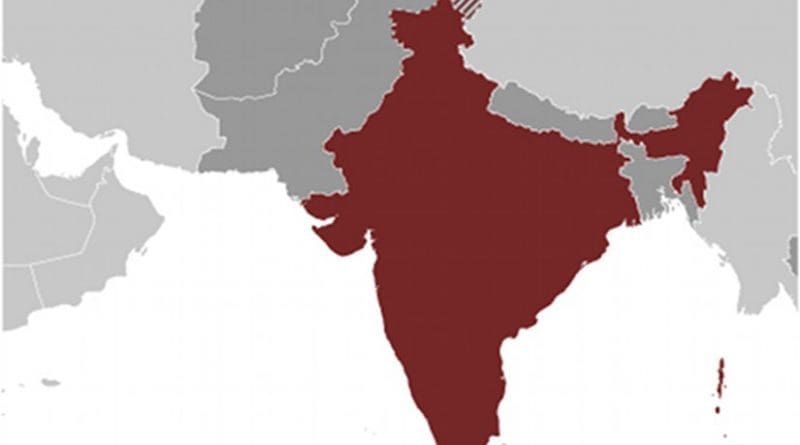The Changing Jihadist Threat In India: Indian Mujahideen’s ISIS Link – Analysis
By RSIS
Indian jihadi groups, such as the Indian Mujahideen, have not pledged allegiance to Al Qaeda or ISIS. Yet many of their members have joined the ranks of ISIS in Syria and Iraq. This is a game changer to jihadism in India, and is significant to the security of the region.
By Vikram Rajakumar*
Indian jihadi groups have long confined their activities to South Asia and refrained from participating in external conflicts. However the advent of the jihadi group ISIS’ self-styled Islamic State caliphate has changed the picture significantly.
The Indian Mujahideen (IM), a militant offshoot of the Students Islamic Movement of India (SIMI) of about 30 members, advocates armed jihad to “liberate” India from western materialist culture and convert the entire population of India to Islam. The IM has forged ties with global terrorist groups like ISIS. The latter’s messages found resonance among members of IM, particularly IS Leader Abu Bakar Al Baghdadi’s speech, translated into Hindi, called on Indian Muslims to wage armed jihad against the oppressors.
Greater traction than Al Qaeda?
This call by ISIS has had greater traction than that of Al Qaeda in the Indian Sub-continent (AQIS) which was announced by AQ Central’s leader Ayman Al Zawahiri in September 2014. The putative aim of AQIS was to unite all jihadi groups in South Asia under one banner as a consolidated voice for Muslims in the region. IM is affiliated with AQ-linked groups such as Lashkar–E-Taiba (LeT), Jaish-E-Mohammed (JeM), Hizb-ul- Mujahideen (HM), Harkat-ul-Jihad Al-Islam (HuJI) and Jamaat ul-Mujahideen (JMB). There are also networks of jihadi groups spanning Pakistan and Myanmar.
The IM has been active in many of India’s larger cities where it targets areas of high population density. Members of the group have reportedly undergone intensive militant training in Pakistan under Al Qaeda’s remit. Some of the significant attacks were in Lucknow, Faisalabad and Varanasi in 2007; serial bombings in Jaipur, Delhi, Bangalore and Ahmedabad in 2008; Pune and Chinaswamy Stadium blasts in 2010; Hyderabad twin blasts and the Bodhgaya blasts in 2013.
ISIS’ call for armed jihad has held greater sway because of the symbolism of the caliphate and the ostensible obligation of Muslims to serve its purported mission to protect their brethren the world over. In the circumstances with the relative loss of AQ’s influence vis-à-vis ISIS the shift of allegiance to the latter is inevitable.
Involvement in external conflicts
The Ansar-ut Tawhid fi Bilad al-Hind (AuT), the newest of the armed jihadist groups in South Asia, was formed in 2013 through a coalescing of members of the IM, ISIS and the Afghan Taliban in 2013. The deceased leader of the group, Abdul Khadir Sultan Armar, who had been endorsed by Baghdadi, was a former member of the IM.
Furthermore, several members of the IM have joined ISIS in Syria and vowed to carry out attacks on Indian soil on behalf of ISIS. There are currently about 10 members, who have either moved to Syria and Iraq or have been planning attacks and recruiting in India.
Quite apart from the shifts in group loyalties, there has been a significant shift in schools of thought. The IM subscribes to the Deobandi school of thought whereas ISIS adopts the Salafi school of thought. To be sure, the IM as a group has not sworn allegiance to Baghdadi, even though many of its members are also members of ISIS. Neither has there been an open claim made so far by the IM leadership, confirming affiliation with Al Qaeda or any of the other Jihadi groups, despite having been reportedly trained by Al Qaeda in Pakistan.
Shift in Ideology
IM members’ new affiliation with ISIS raises a question of significance to the shape of contemporary jihadist movements in South Asia. Persuaded by ISIS’ play of symbolism, IM changed its ideological orientation, from being AQ-centric to ISIS–centric. If IM can do this, other groups or individuals who subscribe to the worldview of radical Islamist politics — who consider it a religious obligation to establish and live in a Caliphal system of governance — can also do so unhindered, despite competition between Al-Qaeda and ISIS.
Initially, intelligence circles did not think that ISIS, considering its focus on the Middle East, would pose a threat to India. This was an assessment premised on Indian jihadism’s general ambivalence towards partaking in a terrorist agenda beyond its shores. However, the direct involvement of IM’s members with ISIS as its surrogates in India has proven to be a game changer for India’s national security in respect of contemporary jihadism.
IM has been sold on ISIS’ propaganda, that its goals can be realised if it combines forces with the global terrorist organisation. And, as the Deobandi school of thought pervades much of the practice of Islam in South Asia, the question arises as to the extent to which South Asian groups are vulnerable to being subverted to serve ISIS’ cause in the region.
The hitherto insular bent of contemporary jihadism in India and its subscription to a school of thought in Islam that is different from what Al Qaeda or ISIS subscribes to, has not stopped IM members from partaking in ISIS’ global agenda from the Middle East. It is only a matter of time before members of other Indian Jihadi groups and indeed the region, follow suit.
*Vikram Rajakumar is a Senior Analyst at the International Centre for Political Violence and Terrorism Research (ICPVTR) at the S. Rajaratnam School of International Studies (RSIS), Nanyang Technological University, Singapore.

